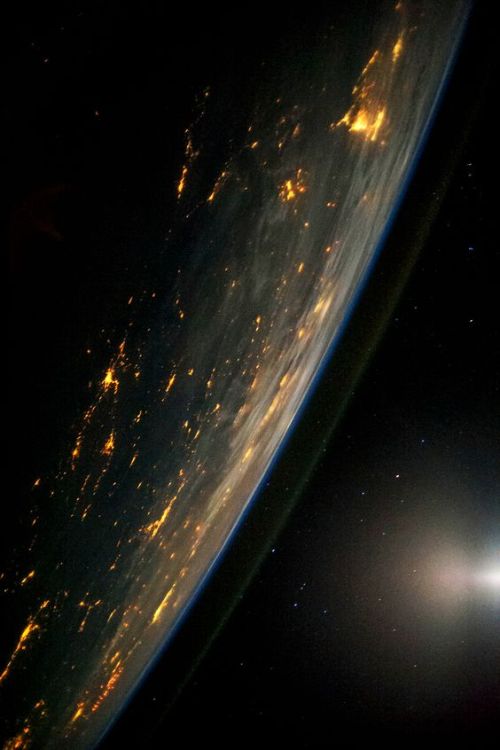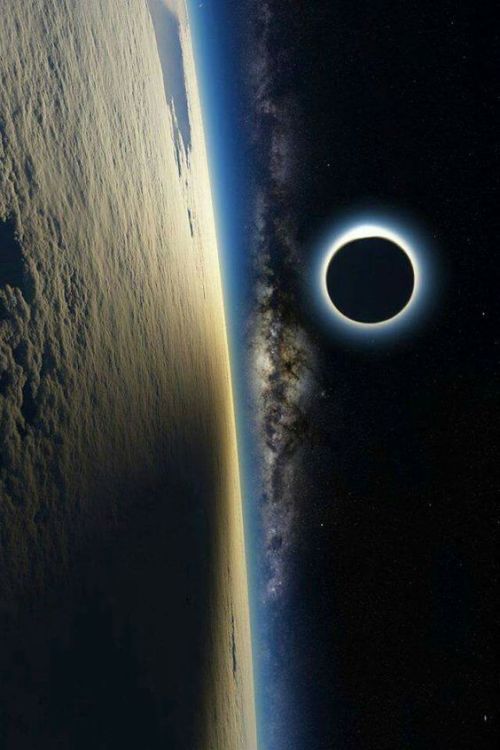Observations Of Earth, Soyuz, Moon And Space Shuttle Endeavor Made From The International Space Station.








Observations of Earth, Soyuz, moon and Space Shuttle Endeavor made from the International Space Station.
source: images.nasa.gov
More Posts from Ocrim1967 and Others








If the Moon were replaced with some of our planets (at night)
Image credit: yeti dynamics
Mis conversaciones favoritas son aquellas que se tienen con el lápiz y el papel.
-Zufriedenheit.










This Is How The Universe Changes With Every New Year That Passes
“With an 13.8 billion year lifetime so far, the Universe has certainly been around for some time. While it may seem to change only imperceptibly on human timescales, the fact remains that these changes are real, important, and cumulative. If we look closely and precisely enough, we can observe these changes on timescales as small as a single year.
These changes affect not only our home world, but our Solar System, galaxy, and even the entire Universe. We are only in the beginning stages of exploring how the Universe changes over time and what it looks like at the greatest distances and faintest extremes. May the 2020s mark the decade, at long last, where we pool our efforts as a species into the endeavor to uncover the greatest cosmic secrets of all.”
With every year that goes by, tiny, imperceptible changes occur in our physical Universe that really add up over time. The Earth’s rotation is slowing, the Moon is spiraling outwards, the Sun is heating up and new stars are forming. On a cosmic scale, the Universe is expanding and getting cooler, and more galaxies are becoming visible while fewer stars are capable of being visited.
This is how the Universe changes with each new year that passes, and we can quantify the effects today!
Greatest Hits — Craters We Love
Our solar system was built on impacts — some big, some small — some fast, some slow. This week, in honor of a possible newly-discovered large crater here on Earth, here’s a quick run through of some of the more intriguing impacts across our solar system.
1. Mercury: A Basin Bigger Than Texas

Mercury does not have a thick atmosphere to protect it from space debris. The small planet is riddled with craters, but none as spectacular as the Caloris Basin. “Basin” is what geologists call craters larger than about 186 miles (300 kilometers) in diameter. Caloris is about 950 miles (1,525 kilometers) across and is ringed by mile-high mountains.
For scale, the state of Texas is 773 miles (1,244 kilometers) wide from east to west.
2. Venus: Tough on Space Rocks

Venus’ ultra-thick atmosphere finishes off most meteors before they reach the surface. The planet’s volcanic history has erased many of its craters, but like almost any place with solid ground in our solar system, there are still impact scars to be found. Most of what we know of Venus’ craters comes from radar images provided by orbiting spacecraft, such as NASA’s Magellan.
Mead Crater is the largest known impact site on Venus. It is about 170 miles (275 kilometers) in diameter. The relatively-flat, brighter inner floor of the crater indicates it was filled with impact melt and/or lava.
3. Earth: Still Craters After All These Years

Evidence of really big impacts — such as Arizona’s Meteor Crater — are harder to find on Earth. The impact history of our home world has largely been erased by weather and water or buried under lava, rock or ice. Nonetheless, we still find new giant craters occasionally.
A NASA glaciologist has discovered a possible impact crater buried under more than a mile of ice in northwest Greenland.
This follows the finding, announced in November 2018, of a 19-mile (31-kilometer) wide crater beneath Hiawatha Glacier – the first meteorite impact crater ever discovered under Earth’s ice sheets.
If the second crater, which has a width of over 22 miles (35 kilometers), is ultimately confirmed as the result of a meteorite impact, it will be the 22nd largest impact crater found on Earth.
4. Moon: Our Cratered Companion

Want to imagine what Earth might look like without its protective atmosphere, weather, water and other crater-erasing features? Look up at the Moon. The Moon’s pockmarked face offers what may be humanity’s most familiar view of impact craters.
One of the easiest to spot is Tycho, the tight circle and bright, radiating splat are easy slightly off center on the lower-left side of the full moon. Closer views of the 53-mile (85 kilometer)-wide crater from orbiting spacecraft reveal a beautiful central peak, topped with an intriguing boulder that would fill about half of a typical city block.
5. Mars: Still Taking Hits

Mars has just enough atmosphere to ensure nail-biting spacecraft landings, but not enough to prevent regular hits from falling space rocks. This dark splat on the Martian south pole is less than a year old, having formed between July and September 2018. The two-toned blast pattern tells a geologic story. The larger, lighter-colored blast pattern could be the result of scouring by winds from the impact shockwave on ice. The darker-colored inner blast pattern is because the impactor penetrated the thin ice layer, blasting the dark sand underneath in all directions.
6. Ceres: What Lies Beneath

The bright spots in Ceres’ Occator crater intrigued the world from the moment the approaching Dawn spacecraft first photographed it in 2015. Closer inspection from orbit revealed the spots to be the most visible example of hundreds of bright, salty deposits that decorate the dwarf planet like a smattering of diamonds. The science behind these bright spots is even more compelling: they are mainly sodium carbonate and ammonium chloride that somehow made their way to the surface in a slushy brine from within or below the crust. Thanks to Dawn, scientists have a better sense of how these reflective areas formed and changed over time — processes indicative of an active, evolving world.
7. Comet Tempel 1: We Did It!

Scientists have long known we can learn a lot from impact craters — so, in 2005, they made one themselves and watched it happen.
On July 4, 2005, NASA’s Deep Impact spacecraft trained its instruments on an 816-pound (370-kilogram) copper impactor as it smashed into comet Tempel 1.
One of the more surprising findings: The comet has a loose, “fluffy” structure, held together by gravity and contains a surprising amount of organic compounds that are part of the basic building blocks of life.
8. Mimas: May the 4th Be With You

Few Star Wars fans — us included — can resist Obi Wan Kenobi’s memorable line “That’s no moon…” when images of Saturn’s moon Mimas pop up on a screen. Despite its Death Star-like appearance, Mimas is most definitely a moon. Our Cassini spacecraft checked, a lot — and the superlaser-looking depression is simply an 81-mile (130-kilometer) wide crater named for the moon’s discoverer, William Herschel.
9. Europa: Say What?

The Welsh name of this crater on Jupiter’s ocean moon Europa looks like a tongue-twister, but it is easiest pronounced as “pool.” Pwyll is thought to be one of the youngest features we know of on Europa. The bright splat from the impact extends more than 600 miles (about 1,000 kilometers) around the crater, a fresh blanket over rugged, older terrain. “Fresh,” or young, is a relative term in geology; the crater and its rays are likely millions of years old.
10. Show Us Your Greatest Hits

Got a passion for Stickney, the dominant bowl-shaped crater on one end of Mars’ moon Phobos? Or a fondness for the sponge-like abundance of impacts on Saturn’s battered moon Hyperion (pictured)? There are countless craters to choose from. Share your favorites with us on Twitter, Instagram and Facebook.
Make sure to follow us on Tumblr for your regular dose of space: http://nasa.tumblr.com










🐱:(source)


Gif by Satiricon










FOR SALE: Mobile &Web Illustration




Ψ ♥ For more interesting psychology posts like this, follow @mypsychology ♥ Ψ







The galaxy is perfect
Earth: Our Oasis in Space

Earth: It’s our oasis in space, the one place we know that harbors life. That makes it a weird place – so far, we haven’t found life anywhere else in the solar system…or beyond. We study our home planet and its delicate balance of water, atmosphere and comfortable temperatures from space, the air, the ocean and the ground.

To celebrate our home, we want to see what you love about our planet. Share a picture, or several, of Earth with #PictureEarth on social media. In return, we’ll share some of our best views of our home, like this one taken from a million miles away by the Earth Polychromatic Imaging Camera (yes, it’s EPIC).

From a DC-8 research plane flying just 1500 feet above Antarctic sea ice, we saw a massive iceberg newly calved off Pine Island Glacier. This is one in a series of large icebergs Pine Island has lost in the last few years – the glacier is one of the fastest melting in Antarctica.

It’s not just planes. We also saw the giant iceberg, known as B-46, from space. Landsat 8 tracked B-46’s progress after it broke off from Pine Island Glacier and began the journey northward, where it began to break apart and melt into the ocean.

Speaking of change, we’ve been launching Earth-observing satellites since 1958. In that time, we’ve seen some major changes. Cutting through soft, sandy soil on its journey to the Bay of Bengal, the Padma River in Bangladesh dances across the landscape in this time-lapse of 30 years’ worth of Landsat images.

Our space-based view of Earth helps us track other natural activities, too. With both a daytime and nighttime view, the Aqua satellite and the Suomi NPP satellite helped us see where wildfires were burning in California, while also tracking burn scars and smoke plumes..

Astronauts have an out-of-this-world view of Earth, literally. A camera mounted on the International Space Station captured this image of Hurricane Florence after it intensified to Category 4.

It’s not just missions studying Earth that capture views of our home planet. Parker Solar Probe turned back and looked at our home planet while en route to the Sun. Earth is the bright, round object.
Want to learn more about our home planet? Check out our third episode of NASA Science Live where we talked about Earth and what makes it so weird.
Make sure to follow us on Tumblr for your regular dose of space: http://nasa.tumblr.com
-
 lemur4444 liked this · 4 years ago
lemur4444 liked this · 4 years ago -
 crissillis liked this · 5 years ago
crissillis liked this · 5 years ago -
 llustforllife liked this · 5 years ago
llustforllife liked this · 5 years ago -
 lesbianmelkor reblogged this · 6 years ago
lesbianmelkor reblogged this · 6 years ago -
 botticellis-primavera reblogged this · 6 years ago
botticellis-primavera reblogged this · 6 years ago -
 botticellis-primavera liked this · 6 years ago
botticellis-primavera liked this · 6 years ago -
 degenerarchy reblogged this · 6 years ago
degenerarchy reblogged this · 6 years ago -
 luftnxchoben-blog reblogged this · 6 years ago
luftnxchoben-blog reblogged this · 6 years ago -
 shakethedesease liked this · 6 years ago
shakethedesease liked this · 6 years ago -
 yuppj reblogged this · 6 years ago
yuppj reblogged this · 6 years ago -
 pinaojazz liked this · 6 years ago
pinaojazz liked this · 6 years ago -
 johnspartan1974 liked this · 6 years ago
johnspartan1974 liked this · 6 years ago -
 dune-mosse reblogged this · 6 years ago
dune-mosse reblogged this · 6 years ago -
 dune-mosse liked this · 6 years ago
dune-mosse liked this · 6 years ago -
 memeboycolor reblogged this · 6 years ago
memeboycolor reblogged this · 6 years ago -
 thegreatdangus reblogged this · 6 years ago
thegreatdangus reblogged this · 6 years ago -
 totheswamp reblogged this · 6 years ago
totheswamp reblogged this · 6 years ago -
 calmingstuff reblogged this · 6 years ago
calmingstuff reblogged this · 6 years ago -
 inspirationandmore reblogged this · 6 years ago
inspirationandmore reblogged this · 6 years ago -
 omasgarten reblogged this · 6 years ago
omasgarten reblogged this · 6 years ago -
 streawberige liked this · 6 years ago
streawberige liked this · 6 years ago -
 keejot reblogged this · 6 years ago
keejot reblogged this · 6 years ago -
 avocadoozlampasami-blog liked this · 6 years ago
avocadoozlampasami-blog liked this · 6 years ago -
 messier47 reblogged this · 6 years ago
messier47 reblogged this · 6 years ago -
 messier47 reblogged this · 6 years ago
messier47 reblogged this · 6 years ago -
 milkywayan reblogged this · 6 years ago
milkywayan reblogged this · 6 years ago -
 vulpusrex reblogged this · 6 years ago
vulpusrex reblogged this · 6 years ago -
 calmingstuff reblogged this · 6 years ago
calmingstuff reblogged this · 6 years ago -
 iird98 liked this · 6 years ago
iird98 liked this · 6 years ago